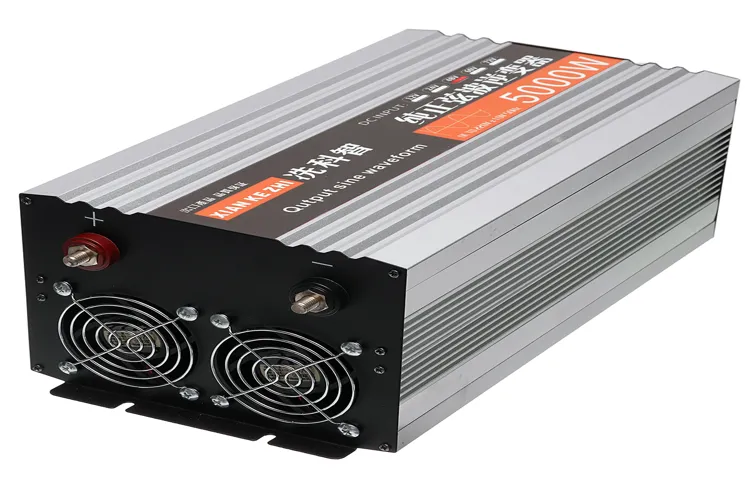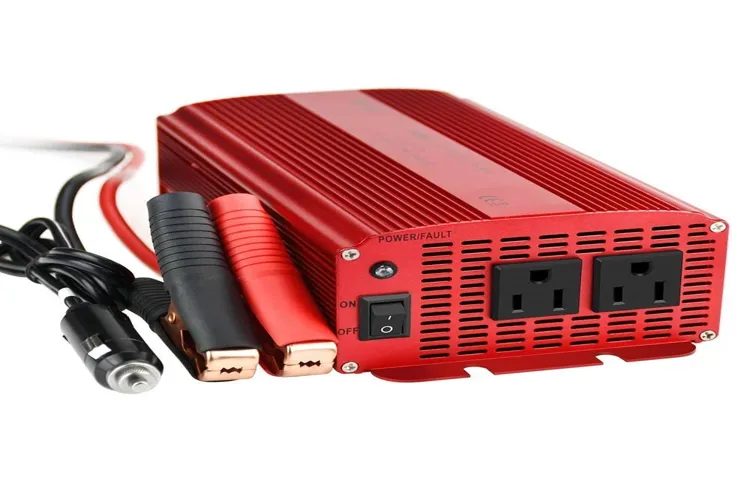Are you struggling to understand what a power inverter is and how it actually works? Well, you’re not alone! Many people find themselves scratching their heads when it comes to this topic. But fear not, because I’m here to break it down for you in simple, easy-to-understand terms. So, let’s start with the basics.
A power inverter is a device that converts DC (direct current) electricity into AC (alternating current) electricity. Essentially, it takes the power from a battery or a DC power source and transforms it into the type of electricity that can be used to power household appliances and electronics. Think of it like this: imagine you have a battery that stores energy in the form of direct current (DC).
This DC energy is like a one-way street, flowing in a single direction. Now, imagine you have a household appliance that needs alternating current (AC) to operate. AC electricity is like a two-way street, constantly changing direction.
Here’s where the power inverter comes in. It acts as the middleman, taking the DC power from the battery and converting it into AC power that can be used by your appliances. It does this by using electronic components like transformers and switches to change the voltage and frequency of the electricity.
Just like turning a switch on and off to control the flow of water through a hose, the power inverter switches the flow of electricity back and forth at a rapid rate, creating an alternating current. This AC power is then sent to your appliances, allowing them to operate as if they were plugged into a regular wall outlet. So, in a nutshell, a power inverter takes DC power and converts it into AC power, allowing you to use your appliances and electronics wherever you go.
It’s a handy device to have, especially if you’re on the road or in an area without access to a traditional power source. Now that you have a better understanding of what a power inverter is and how it works, you’ll be able to make more informed decisions when it comes to choosing the right one for your needs. Whether you’re camping, traveling, or simply want a backup power source for emergencies, a power inverter can be a game-changer.
Table of Contents
Understanding Power Inverters
Power inverters are devices that convert direct current (DC) power into alternating current (AC) power, allowing you to use electronic devices and appliances that operate on AC power when you only have access to DC power. You may wonder, “What is a power inverter used for?” Well, power inverters have a wide range of applications, both in residential and commercial settings. They are commonly used in vehicles, such as cars, RVs, and boats, to power devices like laptops, smartphones, and portable DVD players.
They can also be used during power outages or in remote areas where there is no access to the grid. In addition, power inverters are essential for renewable energy systems, such as solar panels and wind turbines, as they convert the DC power generated by these sources into AC power that can be used to power homes and businesses. So, whether you’re on the road, in a remote location, or harnessing renewable energy, a power inverter is a versatile and valuable tool to have.
Definition of a Power Inverter
power inverter, understanding power inverters

Principle of Power Inversion
power inverters, power inversion, understanding power inverters
Types of Power Inverters
power inverters
Common Uses of Power Inverters
Power inverters have a wide range of uses in everyday life. One common use of a power inverter is to power electronic devices while on the go. For example, if you’re traveling in an RV or camper, a power inverter can convert the DC power from your vehicle’s battery to AC power, allowing you to use appliances and charge your devices.
This is especially convenient for road trips or camping trips where access to electrical outlets may be limited. Power inverters are also useful in emergency situations or power outages. They allow you to connect essential devices like lights, radios, and small appliances directly to your car’s battery, providing you with a source of power when you need it most.
Additionally, power inverters are commonly used in renewable energy systems, such as solar panels and wind turbines. They convert the DC power generated by these systems into AC power, which can be used to power homes or businesses. Overall, power inverters offer versatility and convenience in a variety of situations, making them a valuable tool for anyone in need of portable power.
Powering Household Appliances
power inverters, household appliances, common uses
Charging Electronic Devices
power inverters, charging electronic devices, common uses
Operating Power Tools
power inverters, operating power tools
Choosing the Right Power Inverter
So you’re wondering, what is a power inverter used for? Well, let me break it down for you. A power inverter is a nifty device that converts direct current (DC) power into alternating current (AC) power. In simpler terms, it takes the electricity from your car’s battery or a portable generator and transforms it into the type of electricity that can be used to power devices like laptops, smartphones, and even appliances.
Imagine you’re on a road trip and you want to charge your laptop or use a blender for a quick smoothie. Without a power inverter, you’d be out of luck. But with this handy little gadget, you can plug in your devices and enjoy the comforts of home even when you’re on the go.
It’s like having a portable wall socket at your disposal. Pretty cool, right?
Determining Power Needs
power inverter, power needs, choose the right power inverter Determining power needs is an essential step when it comes to choosing the right power inverter for your needs. Whether you’re looking to power small appliances in a vehicle or run larger appliances during a power outage, it’s important to know how much power you’ll need. To determine your power needs, start by making a list of all the appliances and devices you plan to power with the inverter.
Take note of their power requirements, which can usually be found on the device itself or in the user manual. Add up the wattage of all the devices to get your total power requirement. It’s also important to consider factors like the starting current of certain appliances, as some devices require more power when they initially start up.
By accurately assessing your power needs, you can ensure that you choose a power inverter that can handle the load and provide reliable power for your devices.
Considering Waveform
choosing the right power inverter
Tips for Using a Power Inverter
A power inverter is a device that converts DC (direct current) power from a battery or other power source into AC (alternating current) power that can be used to power electrical devices. It is commonly used when there is no access to grid electricity or during power outages. So, what is a power inverter used for? Well, it can be used in a variety of situations.
For example, if you enjoy camping or traveling in an RV, a power inverter can be incredibly useful. It allows you to power your electronic devices, such as laptops, phones, and even small appliances, using the battery power of your vehicle. This means you can still stay connected and enjoy the comforts of home even when you’re on the go.
Power inverters are also frequently used in emergency situations. When the power goes out, a power inverter can be used to provide temporary power to essential appliances like refrigerators, lights, and medical equipment. This can be a real lifesaver during storms or other unforeseen circumstances.
In addition, power inverters are often used by truck drivers who spend long hours on the road. With a power inverter, they can plug in devices like microwaves, refrigerators, or even televisions, making their time on the road more comfortable and convenient. Overall, a power inverter is a versatile device that can be used in many different situations.
Whether you’re camping, facing a power outage, or spending hours on the road, a power inverter can provide you with the power you need to stay connected and comfortable.
Maintaining Battery Life
power inverter, battery life, tips, burstiness
Safely Installing the Inverter
power inverter, installing the inverter, tips for using a power inverter, safely installing the inverter Are you planning to install a power inverter in your vehicle? It’s a great choice for providing portable power on the go, whether you need to charge your electronic devices or run small appliances. However, it’s important to install the inverter safely to ensure it functions properly and doesn’t pose a risk. Here are some tips to keep in mind when installing and using a power inverter.
Firstly, choose a suitable location for the inverter. It should be placed in a well-ventilated area to prevent overheating. Make sure there is enough clearance around the inverter for air circulation.
Additionally, avoid mounting the inverter near flammable materials or in areas where it can be easily damaged. Next, connect the inverter to the battery using the appropriate wiring. It’s crucial to use suitable cables with the correct gauge to handle the power load.
If the cables are too thin, they may heat up and cause a voltage drop, reducing the inverter’s efficiency. On the other hand, if the cables are too thick, they may be difficult to connect and waste unnecessary energy. Before connecting any devices or appliances, always double-check the inverter’s power rating and the requirements of the equipment you are planning to use.
Using devices that require higher power than the inverter can handle can damage both the inverter and the devices. It’s best to start with low-power devices and gradually add more as you become familiar with the inverter’s capabilities. Lastly, pay attention to the inverter’s safety features.
Some inverters have built-in protection mechanisms such as short-circuit protection, overload protection, and temperature sensors. These safety features are designed to keep the inverter and connected devices safe. Familiarize yourself with the inverter’s manual to understand how these safety features work and how to troubleshoot any issues that may arise.
Protecting Sensitive Electronics
power inverter, sensitive electronics, protection
Conclusion
In conclusion, a power inverter is like the Clark Kent of the electronics world. By slyly transforming direct current (DC) into the more versatile alternating current (AC), it unleashes the true superpower of our favorite gadgets. Just like Superman, it saves the day by allowing us to plug our devices into a variety of power sources, whether it be our trusty car battery or that hidden outlet in a remote cabin.
So next time you’re in need of a power boost, remember that the power inverter is the unsung hero, quietly and efficiently converting the energy we need to keep our lives powered up and running smoothly. Up, up, and invert!”
FAQs
What is a power inverter used for?
A power inverter is used to convert DC (direct current) power from a battery or other power source into AC (alternating current) power that can be used to operate household appliances and electronics.
How does a power inverter work?
A power inverter works by using electronic circuits to convert the low voltage DC power from a battery or power source into a higher voltage AC power that can be used to run appliances and devices.
Can a power inverter be used in a car?
Yes, power inverters are commonly used in cars to provide AC power for devices such as laptops, smartphones, and other electronics.
What size power inverter do I need for my appliances?
The size of the power inverter you need depends on the power requirements of your appliances. It is important to consider the wattage and surge power requirements of your devices when choosing a power inverter.
Are there different types of power inverters?
Yes, there are different types of power inverters, including modified sine wave inverters and pure sine wave inverters. Modified sine wave inverters are more affordable but may not be suitable for certain devices, while pure sine wave inverters provide a cleaner and more stable power output.
Can a power inverter be used for outdoor activities?
Yes, power inverters can be used for outdoor activities such as camping or tailgating to power small appliances like portable fridges, fans, and lights.
Can a power inverter be used with solar panels?
Yes, power inverters are commonly used with solar panels to convert the DC power generated by the panels into AC power that can be used to run household appliances and feed back into the electrical grid.



